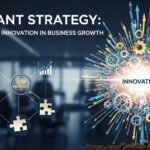The velocity of technological advancement has created an unprecedented challenge for business leaders. While emerging technologies promise transformative opportunities, they also demand specialized expertise that traditional hiring models struggle to deliver. Organizations find themselves caught between the imperative to innovate and the practical limitations of building internal capabilities fast enough to capitalize on rapidly evolving opportunities.
This dynamic has fundamentally altered the strategic calculus around talent acquisition and capability development. The most successful enterprises are those that recognize the futility of trying to build every capability internally and instead focus on orchestrating the right combination of internal and external expertise to drive innovation at market speed.
The Innovation Velocity Imperative
Market leadership increasingly belongs to organizations that can translate emerging technologies into competitive advantages faster than their competitors. This race isn’t simply about being first to market with new features or capabilities. It’s about establishing sustainable technological advantages that create barriers to entry and defendable market positions.
Consider the current landscape of emerging technologies: artificial intelligence, machine learning, blockchain, quantum computing, augmented reality, Internet of Things, and edge computing. Each represents potential disruption across multiple industries. Organizations that can successfully integrate these technologies into their business models will capture disproportionate value, while those that lag behind risk obsolescence.
The challenge lies in the specialized nature of these emerging fields. Unlike established technologies where talent pools are mature and training resources abundant, emerging technologies require expertise that exists in limited quantities globally. The professionals who understand these technologies at implementation level are scarce, expensive, and often concentrated in specific geographic regions or already committed to other organizations.
The Expertise Scarcity Problem
Traditional hiring approaches fail in emerging technology contexts because they assume talent availability and transferable skills. In reality, the professionals who can implement artificial intelligence solutions, develop blockchain architectures, or design quantum computing algorithms represent a tiny fraction of the overall technology workforce. These individuals often possess unique combinations of theoretical knowledge, practical experience, and domain-specific insights that cannot be quickly replicated through training programs.
The scarcity problem compounds when organizations attempt to build comprehensive internal capabilities across multiple emerging technology domains. The cost and complexity of attracting, retaining, and managing such specialized talent internally often exceeds the economic value of the innovations they produce, particularly in the exploratory phases of technology adoption.
Furthermore, the rapid evolution of these fields means that expertise becomes outdated quickly. Professionals who were considered experts in specific areas may find their knowledge superseded by new developments within months. This creates a continuous learning and adaptation requirement that challenges traditional employment models and career development frameworks.
Strategic Talent Orchestration
The most sophisticated organizations approach emerging technology innovation through strategic talent orchestration rather than traditional hiring. This involves creating flexible frameworks that can rapidly assemble and disassemble teams based on specific technological requirements and project phases.
Technology staff augmentation companies excel in this orchestration model because they maintain networks of specialists across multiple emerging technology domains. These organizations invest in continuous talent development, stay current with technological evolution, and can rapidly deploy expertise where it’s needed most. This approach allows client organizations to focus their internal resources on strategic direction and core business integration while leveraging external expertise for specialized implementation work.
The orchestration model also enables organizations to experiment with emerging technologies without making permanent commitments to specific talent pools. Projects can be launched with external expertise, validated through market response, and then scaled through appropriate combinations of internal and external resources based on actual business outcomes rather than theoretical projections.
Innovation Through Cognitive Diversity
One of the most underappreciated advantages of staff augmentation in emerging technology contexts is the cognitive diversity it introduces. Different professionals bring varied perspectives, methodological approaches, and problem-solving frameworks based on their unique experiences and backgrounds. This diversity often leads to breakthrough innovations that homogeneous internal teams might never discover.
Emerging technologies particularly benefit from diverse cognitive approaches because they often require creative applications of fundamental principles to solve novel problems. The intersection of different perspectives and methodologies frequently produces solutions that transcend the limitations of any single approach. Organizations that embrace this diversity gain access to a broader solution space and often discover unexpected applications for emerging technologies.
Additionally, external specialists bring exposure to different industry applications and implementation strategies. A machine learning expert who has worked across healthcare, finance, and manufacturing sectors understands pattern recognition and algorithmic approaches that may not be apparent to professionals with more limited domain experience. This cross-pollination of ideas and approaches often leads to innovative solutions that create competitive differentiation.
Risk Mitigation Through Controlled Experimentation
Emerging technology initiatives inherently carry high levels of technical and market risk. The technologies themselves may not perform as expected, market adoption may be slower than anticipated, or competitive responses may neutralize anticipated advantages. Traditional approaches to technology adoption often require substantial upfront commitments that amplify these risks.
Staff augmentation provides a natural framework for controlled experimentation and risk mitigation. Organizations can launch pilot projects with limited resource commitments, validate technical feasibility and market response, and then scale successful initiatives while abandoning unsuccessful ones without significant sunk costs. This approach enables more aggressive innovation portfolios because individual project failures don’t threaten overall organizational stability.
The controlled experimentation model also enables organizations to explore multiple emerging technology opportunities simultaneously. Rather than betting heavily on a single technological approach, organizations can maintain parallel exploration efforts across several promising areas and concentrate resources on those that demonstrate the most potential for competitive advantage.
Accelerated Learning and Knowledge Transfer
Working with external specialists in emerging technology domains creates opportunities for accelerated learning and knowledge transfer that can enhance internal capabilities permanently. The learning that occurs through these collaborations often exceeds formal training programs in both depth and practical applicability because it involves real-world problem-solving rather than theoretical instruction.
Internal team members gain exposure to cutting-edge methodologies, tools, and approaches that they might not encounter through traditional learning channels. This exposure often sparks innovation and creative problem-solving that extends beyond the specific projects where the collaboration occurred. The knowledge transfer creates lasting value that compounds over time and enhances the organization’s overall technological capabilities.
Furthermore, the professional relationships that develop through these collaborations often become valuable resources for future initiatives. External specialists become familiar with the organization’s business context, technical infrastructure, and strategic priorities, enabling more effective future engagements and creating ongoing advisory relationships that support continued innovation.
Building Adaptive Innovation Capabilities
The most successful organizations in emerging technology contexts are those that build adaptive innovation capabilities rather than static technical competencies. This means developing organizational frameworks that can quickly identify promising technological opportunities, rapidly assemble appropriate expertise, and efficiently execute innovation initiatives from concept through market deployment.
Staff augmentation plays a crucial role in these adaptive capabilities because it provides access to specialized expertise without the overhead and inflexibility of permanent hiring. Organizations can maintain lean internal teams focused on strategy, integration, and business application while leveraging external expertise for specialized implementation work as needed.
The adaptive approach also enables organizations to respond quickly to technological breakthroughs or market shifts. When new opportunities emerge, organizations with established augmentation capabilities can rapidly deploy appropriate expertise to capitalize on these opportunities while competitors struggle with traditional hiring and capability-building processes.
Economic Efficiency and Portfolio Management
The economics of emerging technology innovation often favor flexible resource models over permanent hiring. The uncertainty inherent in emerging technology initiatives makes it difficult to justify permanent staffing commitments, particularly in early exploration phases where project success rates may be low and resource requirements highly variable.
Staff augmentation enables organizations to manage emerging technology initiatives as investment portfolios rather than individual projects. Resources can be allocated dynamically based on project progress, market response, and competitive dynamics. Successful initiatives can be scaled rapidly while unsuccessful ones can be terminated without significant personnel disruption.
This portfolio approach also enables organizations to maintain broader innovation portfolios than would be possible with permanent hiring models. The ability to quickly engage and disengage specialized expertise allows organizations to explore more opportunities simultaneously and maintain multiple technological options as markets and competitive landscapes evolve.
Strategic Positioning for Future Advantage
Organizations that successfully leverage staff augmentation for emerging technology innovation often discover that the capabilities they develop through these initiatives create lasting competitive advantages. The operational frameworks, technological insights, and partnership relationships established through these efforts become valuable assets that support future innovation initiatives.
The learning and adaptation that occurs through emerging technology projects also enhances organizational agility and innovation capacity more broadly. Teams that successfully navigate the challenges of implementing artificial intelligence solutions, blockchain architectures, or quantum computing applications develop problem-solving skills and technological sophistication that benefits all future technology initiatives.
Conclusion
The intersection of emerging technologies and competitive advantage represents one of the most significant strategic opportunities of our time. Organizations that can successfully navigate this intersection will capture disproportionate value and establish lasting market positions. Those that fail to adapt will find themselves increasingly marginalized in markets that reward technological sophistication and innovation velocity.
Success in this environment requires more than good intentions or adequate budgets. It demands strategic thinking about talent orchestration, risk management, and capability development that transcends traditional hiring and technology adoption approaches. For organizations ready to embrace this strategic opportunity, partnering with Devsinc provides access to the specialized expertise and operational frameworks needed to transform emerging technology potential into sustainable competitive advantage.






